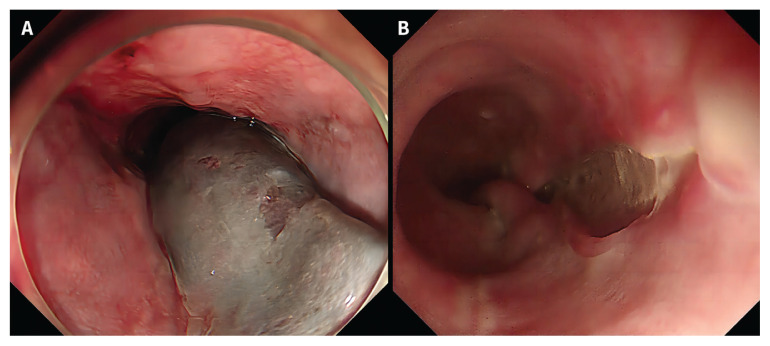A 68-year-old man presented to the emergency department with sudden onset retrosternal pain and dysphagia. He was taking acetylsalicylic acid (100 mg once daily), ticagrelor (90 mg every 12 h), rosuvastatin (10 mg once nightly) and long-acting metoprolol (47.5 mg once daily) for coronary artery disease. The patient had 2 stents placed 1 year previously. Electrocardiography and laboratory investigations of his cardiac biomarkers, complete blood count and international normalized ratio were normal. A computed tomography scan of his chest showed a longitudinal, variable-density, intraluminal mass in the esophagus (Appendix 1, available at www.cmaj.ca/lookup/doi/10.1503/cmaj.221673/tab-related-content). Upper gastrointestinal endoscopy showed a hematoma extending from the upper esophagus to the cardia (Figure 1A). We diagnosed a spontaneous subepithelial hematoma of the esophagus. We started the patient on parenteral nutrition and stopped the acetylsalicylic acid and ticagrelor. His symptoms resolved over 5 days, and endoscopy performed 1 week after onset showed absorption of the hematoma with only a superficial ulcer remaining (Figure 1B), which we speculate was caused by pressure necrosis from the hematoma. A biopsy of the rim of the ulcer showed squamous epithelium with necrosis. We restarted the patient on acetylsalicylic acid, but not the ticagrelor. He was asymptomatic at follow-up 1 month later.
Figure 1:
(A) Upper gastrointestinal endoscopy of a 68-year-old man showed a bluish submucosal lesion that extended from the upper esophagus to the cardia. (B) After 1 week of treatment, endoscopy showed absorption of the hematoma with only a superficial ulcer remaining.
A subepithelial hematoma of the esophagus is an uncommon esophageal injury, usually arising secondary to trauma or procedure-related complications, or occurring spontaneously in patients receiving antithrombotic therapy,1 as with this patient. The injury may be caused by sudden pressure changes in the esophagus leading to bleeding between the esophageal mucosa and muscularis propria and is of intermediate severity in the spectrum that includes superficial mucosal tears (Mallory–Weiss syndrome) and transmural perforation (Boerhaave syndrome). Symptoms include acute retrosternal pain and dysphagia with or without gastrointestinal bleeding,2,3 making it essential to differentiate from acute cardiopulmonary conditions, since antithrombotic therapy can worsen the hematoma. The prognosis is generally good with conservative therapy.2 Evidence is lacking about when to restart antithrombotic therapy in patients with a spontaneous subepithelial hematoma of the esophagus.
Supplementary Material
Footnotes
Competing interests: None declared.
This article has been peer reviewed.
The authors have obtained patient consent.
Funding: Chinese Academy of Medical Sciences Initiative for Innovative Medicine (grant no. 2021-I2M-1-013) and National High Level Hospital Clinical Research Funding (grant no. 2022-PUMCH-A-076).
References
- 1.Katabathina VS, Restrepo CS, Martinez-Jimenez S, et al. Nonvascular, nontraumatic mediastinal emergencies in adults: a comprehensive review of imaging findings. Radiographics 2011;31:1141–60. [DOI] [PubMed] [Google Scholar]
- 2.Cullen SN, McIntyre AS. Dissecting intramural haematoma of the oesophagus. Eur J Gastroenterol Hepatol 2000;12:1151–62. [DOI] [PubMed] [Google Scholar]
- 3.Mandavdhare HS, Gupta P, Maity P, et al. Image diagnosis: esophageal intramural hematoma in sudden-onset chest pain and dysphagia. Perm J 2018;23:18–141. [DOI] [PMC free article] [PubMed] [Google Scholar]
Associated Data
This section collects any data citations, data availability statements, or supplementary materials included in this article.



